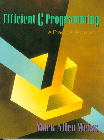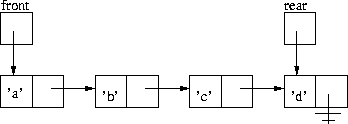 |
Advanced Programming
Spring 2005
Recitation 10: Linked list queue
Week 10: Mar 29-31
Due (on time): 2005-04-05 23:59:59
Due (late): 2005-04-10 23:59:59
|
CS 2213/2211 Advanced Programming Spring 2005 Recitation 10: Linked list queue Week 10: Mar 29-31 Due (on time): 2005-04-05 23:59:59 Due (late): 2005-04-10 23:59:59 |
Recitation 10 should be submitted
following directions at: submissions with deadlines
|
| Requirements for Part A |
|---|
|
Here is a diagram showing what the queue should look like:
 |
| Requirements for Part B |
|---|
|
|
Contents of email submission
for Recitation 10: Last Name, First Name; Course Number; Recitation Number. a. Give code for the three files queue.c, queue.h and queue_test.c. b. Give results of a run similar to the run for the stack.
|